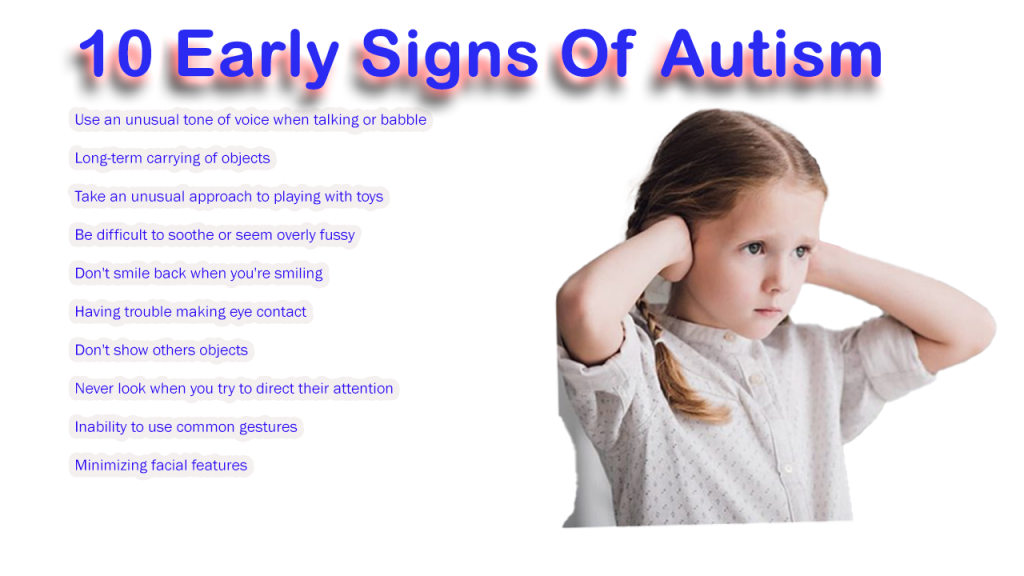It cannot be overstated how important it is to recognize autism spectrum disorder (ASD) at a young age. Early treatment can have a great deal of benefit for children and their families. It may be a sign of early autism to notice abnormalities in a baby’s social behavior and how he or she interacts with a non-social environment. Although a delay in speech on its own usually does not indicate autism, it can be a warning sign when combined with other warning signs.
Early Signs to Not Miss Out
There are several early warning signs that describe what children at risk for an autism spectrum disorder do and do not do between the ages of 12 and 24 months. Toddlers who are typically developing may also exhibit some of the red flags.
- Use an unusual tone of voice when talking or babble
- Long-term carrying of objects
- Take an unusual approach to playing with toys
- Be difficult to soothe or seem overly fussy
- Don’t smile back when you’re smiling
- Having trouble making eye contact
- Don’t show others objects
- Never look when you try to direct their attention
- Inability to use common gestures
- Minimizing facial features
Here is a 10 signs of of Autism, that you need to care about yourself.
Use an unusual tone of voice when talking or babble
The pitch, tone, and volume of vocalizations can be unvarying in a child at risk for autism. The vocalizations of a child who is not yet able to speak may resemble non-word sounds (e.g., whining, fussing, growling) instead of sentences.
Long-term carrying of objects
Objects that are usual or unusual can seem particularly enticing to a child at risk for autism. Children may insist on carrying multiple balls at once whenever possible, or they may want to carry th eir parents’ checkbook at all times. Having access to these items might soothe the child, while denying access might cause the child to become distressed.
Take an unusual approach to playing with toys
In children with autism, toys may be used differently from how they are typically used, or they may not be played with. These objects may be used differently by a child than by an adult.
Be difficult to soothe or seem overly fussy
The frequency with which children with autism cry or tantrum might vary from other children. There may also be no obvious cause for the crying or fussing, as well as the child not being soothed by common calming techniques.
Don’t smile back when you’re smiling
While a child at risk for autism may smile and laugh at you on his or her own and look very happy, he or she may not reply to your smile or playfulness.
Having trouble making eye contact
When a child is at risk for autism, he or she may not use eye gaze appropriately for initiating, ending, or regulating social interactions. There are, however, some children with autism spectrum disorders who are able to make eye contact and gaze with appropriate intensity.
Don’t show others objects
There will be times when children at risk for autism will not show objects to other people or will show them in an inconsistent or partial manner. An individual with autism may only show objects to others to ask for assistance, as opposed to showing objects to others to show enjoyment in the interaction.
Never look when you try to direct their attention
If a parent shifts their gaze in order to shift the child’s attention by turning their head and/or pointing, a child at risk for autism may not look at the object or another part of the room that is far away.
Inability to use common gestures
The use of common gestures, such as shaking the head for no, raising the hand when surprised, or nodding, may not occur spontaneously, prompted, or imitated by a child at risk for autism. Also, children who are at risk for autism may make unusual or unclear gestures.
Minimizing facial features
In general, a child at risk for autism may not display or direct facial expressions beyond emotional extremes (e.g., angry or happy) if he or she is happy, sad, surprised, scared, curious, or other complex emotions.
How is ACNS Helping Children With Autism?
Since its foundation on 2nd of April, 2008, AutismCare Nepal Society (ACNS) has been helping children with autism and their families to protect and promote their rights. ACNS also makes sure to utilize their skills to have a meaningful and effective participation in the society. Furthermore, ACNS also raises awareness on a nationwide level through multimedia platforms. This has hence helped a lot of families to recognize autism at an early age and help them grow in a similar fashion.

Pingback: What is Autism? - AutismCare Nepal Society
can a person of 45 years notice if he have autism?